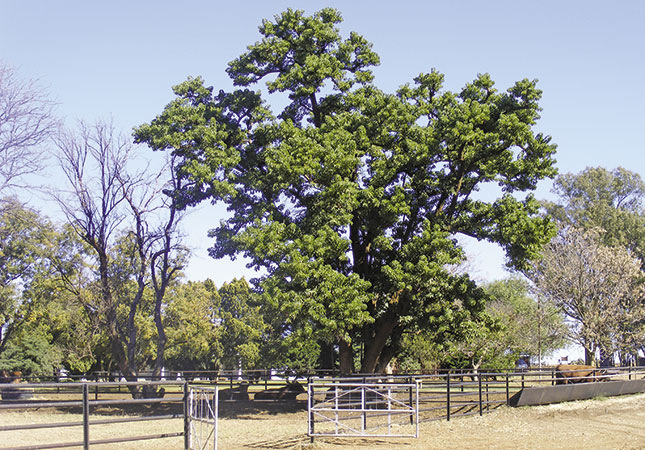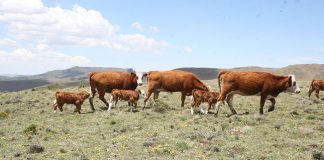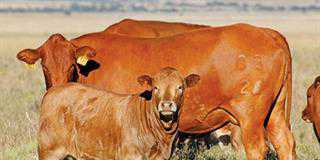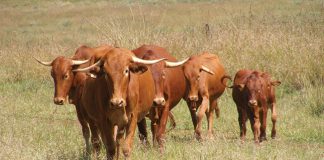
Father and son Johan and JM Steyn’s Vansia Red Angus stud is one of the oldest in South Africa. Johan founded Vansia in 1975 with cows from breeders Hannes Muller, Barry Kramer and Charles Pope. JM joined him in 1999.
Sires such as Elslie Victory (268), Tarzan Kingwheel (900), Tarzan Heavenly (49) and Prinsvlei Rambo (9903) formed its backbone. The Steyns have also bred a number of prominent genetic dam lines such as Vansia Sonja, Pop and Sussie.
Johan says that including stud breeding in his farming enterprise made economic sense at the time. “It costs virtually the same to rear a stud animal as a commercial animal but the return on investment for the former is considerably higher.”
Johan chose the Angus because of its adaptability, polledness, excellent temperament and meat quality. He settled on the Red Angus because red cattle had become sought-after in the area where he farmed. “Around 85% of our buyers are commercial cattlemen, mostly from the Free State, North West and Northern Cape. The Red Angus realises higher auction prices in our part of the world, while our Botswana and Namibia clients also prefer them red,” he says.

Johan and Wilma Steyn (left), and JM and his wife Carita (right), work together as a team. (Photo by Annelie Coleman)
Vansia’s herd is run on the farm Van Wyksrust near Bothaville. The diversified enterprise consists of the stud and a crop division – maize and sunflower – run by JM’s brother Danus, as well as a 100-cow commercial Brangus herd. The stud consists of 100 breeding cows and 30 replacement heifers and brings in a quarter of the farm’s income.
“We have a relatively small farm and don’t have the capacity to expand horizontally. That is why we’re committed to selecting only the best-performing animals that earn top prices,” Johan says. “Commercial cattlemen form the backbone of the beef industry. They are discerning buyers and we have to produce breeding stock meeting their requirements.”
Climate
Van Wyksrust has 24 camps, each with a watering point supplied from a borehole. The annual rainfall varies from 300mm to 700mm. Temperatures fall below freezing in winter and reach in excess of 30°C in summer. The sweetveld grazing includes Eragrostis grasses such as E. curvula (weeping lovegrass) and Themeda traindra (red grass). The carrying capacity is 6ha/ MLU. The stud is run on veld as well as pasture, including 200ha Smuts finger grass, 3ha lucerne and 50ha Silk sorghum. Around 20ha is planted to maize for silage.
Grain stover forms a vital part of the winter fodder flow. The herd is rotated according to the condition of the veld, stover and pastures. A summer phosphate lick and a winter protein lick are provided as a supplement.
Selection and breeding seasons
A successful stud breeder knows the way to the nearest abattoir, according to Johan. Any animal that does not meet the stud’s high selection standards is culled. Every Vansia female two years and older must wean a good calf with a weaning index above 90 on the veld annually, or be culled. The bulls are medium-framed and well-balanced with a strong walking ability. They are fit and muscular with sufficient depth, length and width.
Temperament is an important trait at Vansia. Docile cattle are easier and cheaper to handle, have better growth and achieve higher prices. They also cause and suffer fewer injuries, lose less weight and require less labour. The Steyns maintain two breeding seasons – August and September, and January and February.
Johan explains that when a breeder selects for function, the correct form automatically follows. Bulls’ selection traits include birth and weaning weights, milk production and functionality. Around 80% of the cows are artificially inseminated as genetic variation is key to success in the operation. AI requires fewer bulls on the farm and enables greater genetic diversity.
“We use semen from selected bulls, including from Canada, the US and South Africa,” says JM. “We recently imported semen from the Bieber Angus stud in the US. We favour bulls with a high correlation between feed conversion efficiency, growth and meat yield. Our strict selection for optimum growth has resulted in cattle that produce more beef per hectare.”
The Steyns inseminate 90 females in August and September and 40 in January and February. The higher number in August and September is due to stover being available for grazing in winter. JM and his wife Carita carry out the insemination. Any female that does not conceive in the first round is inseminated again after three weeks. Bulls are then put to the females after insemination at a rate of one bull to about 50 females.
Heifers are inseminated for the first time at 22 months and those that do not conceive in the first season are culled. The stud maintains an average intercalving period of 388 days and an average birth weight of 38kg. The average seven-month weaning weight for bull calves is 270kg and 260kg for heifers.
Disease prevention
The cattle are vaccinated against diseases such as lumpy skin disease, Rift Valley fever and stiff sickness, as well as quarter-evil, botulism and anthrax. Bulls are tested for fertility, CA and TB and then sheath-washed for trichomoniasis and vibriosis. A vet then certifies them disease-free before they are offered for sale.
Johan is concerned about the spread of trichomoniasis and vibriosis in South Africa, warning that they are a real danger. “Commercial cattlemen must test their herds. Do not allow any bull that is not certified disease-free onto your land – it could wipe out your entire cattle herd.”

Vansia bulls are medium-framed and well-balanced, and have a good temperament. Photo by Johann Wehrmeyer
Partnerships and production sales
The stud forms part of the Angus Alliance partnership, which consists of the Vansia, Loumotta, Reolou and Roechama Angus studs. Their next combined annual production sale is set to take place on 19 August on Van Wyksrust. Most of the stud’s animals are marketed through the Angus Alliance Production Sale and the SA National Angus Sale, with a small percentage sold out of hand.
The Steyns are serious contenders in the showring and have consistently taken top places over the years. “It’s important for us to compare our cattle with those of other breeders,” says Johan. “Shows provide the ideal opportunity, and we also consider them as important marketing tools.”
A family team
Johan praises his wife and daughter-in-law for the help they provide. “My wife Wilma and JM’s wife Carita’s support have been invaluable during the past 40 years. Commercial cattlemen will remain our most important clients. We strive to produce genetics that will support sustainable and profitable red meat production, not only locally, but also in the rest of Southern Africa.”
Phone JM Steyn on 072 408 5699 or email [email protected]













